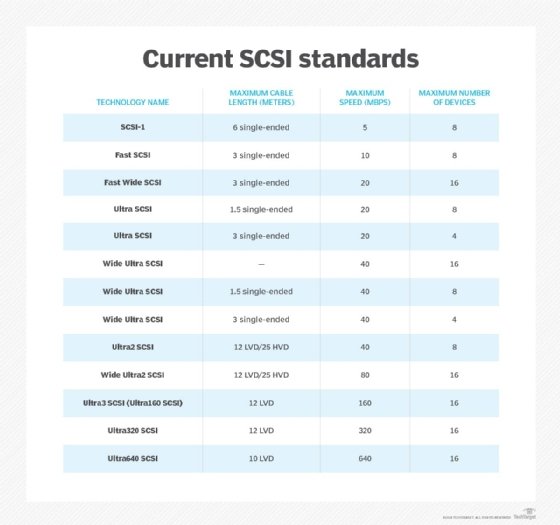SCSI (Small Computer System Interface)
SCSI and devices
Although not all devices support all levels of SCSI, SCSI standards are generally backward-compatible. That is, if an older peripheral device is attached to a newer computer with support for a later standard, the older device will work at the older and slower data rate. In personal computing, SCSI interfaces have been replaced, for the most part, by Universal Serial Bus (USB). In the enterprise, SCSI is still used in server farms for hard drive controllers.
Common SCSI components
There are several components used in SCSI storage systems:
- Initiator. An initiator issues requests for service by the SCSI device and receives responses. Initiators come in a variety of forms and may be integrated into a server’s system board or exist within a host bus adapter. ISCSI connectivity typically uses a software-based initiator.
- Target. A SCSI target is typically a physical storage device (although software-based SCSI targets also exist). The target can be a hard disk or an entire storage array. It is also possible for non-storage hardware to function as a SCSI target. Although rare today, it was once common for optical scanners to be attached to computers through the SCSI bus and to act as SCSI targets.
- Service delivery subsystem. The mechanism that allows communication to occur between the initiator and the target; it usually takes the form of cabling.
- Expander. Only used with serial-attached SCSI (SAS); allows multiple SAS devices to share a single initiator port.
SCSI standards
Current SCSI technologies can transfer up to 640 megabytes per second (MBps).

Serial-attached SCSI
SAS products are compatible with devices that employ earlier SCSI technologies. The Serial Storage Architecture (SSA) standard can be used when SCSI performance is not adequate, as can iSCSI, which preserves the SCSI command set by embedding SCSI-3 (most SCSI-3 specifications start with the designation Ultra) over TCP/IP.
SAS has become a popular alternative to parallel SCSI in enterprise environments. Both serial and parallel SCSI are based on the SCSI command set. SAS offers the following distinct advantages over parallel SCSI:
- It supports up to 65,535 devices (through the use of expanders). The latest parallel SCSI standards allow for only 16 devices.
- it eliminates issues with termination and clock skew.
- It is a point-to-point technology. This means SAS is not subject to the resource contention issues that are so common with parallel SCSI.
SAS vs. SATA
Like SAS, SATA is a serial bus that replaces the aging parallel ATA (PATA) standard. The SATA-3 standard is rated at 6 gigabits per second (Gbps)/600 MBps, which is slightly slower than the Ultra640 SCSI standard. Similarly, SATA-2 has a transfer speed of 3 Gbps/300 MBps, which is just below that of Ultra320 SCSI.
SAS is backward-compatible with SATA-2 and above. A SATA-2 drive can be connected to a SAS backplane. This is possible because both SAS and SATA drives use the SCSI command set. Conversely, SAS drives cannot be connected to a SATA controller.